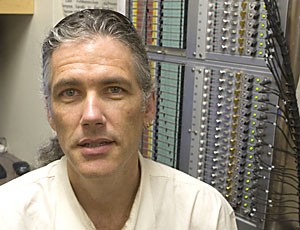An honest man has a firm handshake and a steady gaze. A liar will avoid your eyes as he or she tells an untruth. Right?
Not if you ask John Allen, a UA psychology professor. When it comes to telling if someone is lying, “”we’re bad at it,”” he said.
That’s why Allen hopes to use technology to help better determine when a lie is being told.
The technique, sometimes referred to as “”brain fingerprinting,”” uses the measurement of brain waves to detect whether a subject recognizes an object or phrase. Allen refers to his device as a “”recognition detector,”” made of a set of electrodes that are attached to a subject’s head.
Allen is one of eight researchers who received a UA grant to help find ways to combat crime. In an experiment carried out in the Psychophysiology Laboratory to test the technique, Allen had students serve as subjects, performing a virtual crime using a video game to break into a room and steal items from it.
From there, the individuals were immediately questioned about their actions, referencing a list of objects and situations they may have encountered.
The students’ brain waves were measured, and researchers found that there is a particular reaction that occurs in the brain when it sees something it recognizes.
Although polygraph technology is popular, Allen cautioned that “”there’s no such thing as a lie detector,”” adding that polygraph tests, also known as lie detectors, are often “”terrible at exonerating the innocent.””
Those who are given the polygraph test often exhibit the same nervousness and arousal that typically indicate lying, he said. Up to 50 percent of the time, polygraphs indicate falsehoods that do not exist.
Using his “”recognition detector,”” however, Allen said the rate of this type of misread has been lowered to 5 percent occurrence or less.
The only downside to this new device is that it may not detect a lie when told, depending heavily on how well a subject knows what they’re being asked.
In the video game experiment, there was a 50 percent accuracy rate of true positives, in which the device registered recognition by the subject. In a simpler experiment done by Allen involving the memorization of a list of words, there was up to a 95 percent rate of true positives.
With the polygraph as an overly sensitive device and the recognition detector not being sensitive enough, there have been attempts to use the two systems together, but this has not enhanced their reliability, Allen said.
The problem with the recognition detector is that memory is tricky and easily misled. Forgetfulness and false recollection can ruin any usefulness of the recognition detector, he said.
False memories can easily be implanted, often by accident through the repetition of telling the same story or through a badly done interrogation. These false memories have “”the same brainwaves”” as real ones, he added.
Despite the many issues with the recognition detector, a variation of it is currently used in both Japan and Israel, Allen said.
The systems used in other countries measures skin conduction, rather than brain waves, to determine whether or not there is recognition, he said.
Although the technology is imperfect at the moment, Allen and his team have hopes that it could eventually be used in the legal system.









